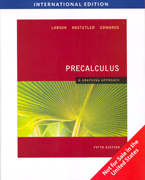
Precalculus (ISE): a graphing approach
Larson, Ron
Hostetler, Robert
Edwards, Bruce H.
Part of the market-leading Graphing Approach series by Larson, Hostetler, andEdwards, PRECALCULUS: A GRAPHING APPROACH, 5e, INTERNATIONAL EDITION, is an ideal student and instructor resource for courses that require the use of a graphing calculator. The quality and quantity of the exercises, combined with interesting applications and innovative resources, make teaching easier and help students succeed. Continuing the series' emphasis on student support, the Fifth Edition introduces Prerequisite Skills Review. For selected examples throughout the text, the Prerequisite Skills Review directs students to previous sections in the text to review concepts and skills needed to master the material at hand. In addition, prerequisite skills review exercises in Eduspace (see below for description) are referenced in every exercise set. The Larson team achieves accessibility through careful writing and design, including examples withdetailed solutions that begin and end on the same page, which maximizes the readability of the text. Similarly, side-by-side solutions show algebraic, graphical, and numerical representations of the mathematics and support a variety of learning styles. Features Updated! The Library of Functions, threaded throughout the text, defines each elementary function and its characteristics at first point of use. The Fifth Edition incorporates new exercises that tests students'' understanding of these functions. All elementary functions are also presented in a summary on the front endpapers of the text for convenient reference. Updated! The Chapter Summaries have been updated to include the Key Terms and Key concepts that are covered in the chapter. These chapter summaries are an effective study aid because they provide a single point of reference for review. Updated! The Proofs of Selected Theorems are now presented at the end of each chapter for easy reference. The Larson team provides an abundance of features that help students use technology to visualize and understand mathematical concepts. Technology Tips point out the pros and cons of technology use in certain mathematical situations. They also provide alternative methods of solving or checking a problem using a graphing calculator. Students may sometimes be misled by the visuals generated by graphing calculators, so the authors use color to enhance the graphing calculator displays in the textbook, where appropriate. This enables students to visualize concepts accurately and efficiently. Technology Support notes appear throughout the text and refer students to the Technology Support Appendix, where they can learn how to use specific graphing calculator features to enhance their understanding of the concepts presented. The Technology Support notes also direct students to the Graphing Technology Guide, on the textbook''s website, for keystroke support for numerous calculator models. Carefully positioned throughout the text, Explorations engage students in active discovery of mathematical concepts, strengthening critical thinking skills and helping them to develop an intuitive understanding of theoretical concepts. What You Should Learn and Why You Should Learn It appears at the beginning of each chapter and section, offering students a succinct list of the concepts they will soon encounter. Additionally, this feature refers students to an application in the exercise set which helps put the math concept into a real-life context so students can understand it better. To help prepare students who intend to move on to Calculus, the authors have placed an icon nextto algebraic techniques that are used in Calculus.
- ISBN: 978-0-495-83207-2
- Editorial: Brooks-Cole
- Encuadernacion: Rústica
- Páginas: 1136
- Fecha Publicación: 01/12/2008
- Nº Volúmenes: 1
- Idioma: Inglés
- Inicio /
- MATEMÁTICAS /
- CÁLCULO
